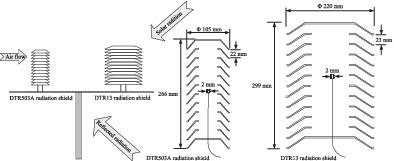当前位置:
X-MOL 学术
›
Meteorol. Appl.
›
论文详情
Our official English website, www.x-mol.net, welcomes your feedback! (Note: you will need to create a separate account there.)
Temperature error‐correction method for surface air temperature data
Meteorological Applications ( IF 2.7 ) Pub Date : 2020-12-13 , DOI: 10.1002/met.1972 Jie Yang 1, 2 , Xuan Deng 1 , Qingquan Liu 1, 2 , Renhui Ding 3
Meteorological Applications ( IF 2.7 ) Pub Date : 2020-12-13 , DOI: 10.1002/met.1972 Jie Yang 1, 2 , Xuan Deng 1 , Qingquan Liu 1, 2 , Renhui Ding 3
Affiliation

|
In climate change research, accurate temperature data are often demanded. However, affected by many factors, especially solar radiation, the accuracy of environmental air temperature measurement can be greatly reduced, since there is a difference in temperature between the environmental air and the related temperature measured by the sensor accommodated inside the radiation shield. In the paper, the term “temperature error” refers to the temperature difference described above. To improve the accuracy of the temperature data, a temperature error‐correction method is proposed. First, a computational fluid dynamics (CFD) method is adopted to quantify the temperature errors accurately. A neural network algorithm is then applied to form a universal correction equation by fitting temperature errors calculated using the CFD method. Finally, to validate the correction equation, field observation experiments are performed. The root mean square error (RMSE) and the mean absolute error (MAE) between the temperature errors obtained experimentally using a sensor inside the DTR503A shield and the corresponding temperature errors determined by using the proposed correction method are 0.043 and 0.038°C, respectively. The RMSE and MAE for the DTR13 radiation shield are 0.049 and 0.044°C, respectively. This method may reduce the error of the temperature data to 0.05°C. If the environmental factors corresponding to the temperature data can be quantified accurately, the factors influencing the temperature error can be added to the correction method continuously. The accuracy of this correction method may be furtherly improved.
中文翻译:

地面空气温度数据的温度误差校正方法
在气候变化研究中,经常需要准确的温度数据。然而,受许多因素的影响,特别是太阳辐射,环境空气温度测量的准确性会大大降低,因为环境空气与通过辐射屏蔽罩内部的传感器测得的相关温度之间存在温度差。在本文中,术语“温度误差”是指上述温度差。为了提高温度数据的准确性,提出了一种温度误差校正方法。首先,采用计算流体动力学(CFD)方法来准确地量化温度误差。然后,通过拟合使用CFD方法计算出的温度误差,将神经网络算法应用于形成通用校正方程。最后,为了验证校正方程,进行了现场观察实验。使用DTR503A屏蔽内的传感器通过实验获得的温度误差与使用建议的校正方法确定的相应温度误差之间的均方根误差(RMSE)和平均绝对误差(MAE)分别为0.043和0.038°C。DTR13辐射屏蔽的RMSE和MAE分别为0.049和0.044°C。此方法可以将温度数据的误差降低到0.05°C。如果可以准确地量化与温度数据相对应的环境因素,则可以将影响温度误差的因素连续添加到校正方法中。该校正方法的精度可以进一步提高。使用DTR503A屏蔽内的传感器通过实验获得的温度误差与使用建议的校正方法确定的相应温度误差之间的均方根误差(RMSE)和平均绝对误差(MAE)分别为0.043和0.038°C。DTR13辐射屏蔽的RMSE和MAE分别为0.049和0.044°C。此方法可以将温度数据的误差降低到0.05°C。如果可以准确地量化与温度数据相对应的环境因素,则可以将影响温度误差的因素连续添加到校正方法中。该校正方法的精度可以进一步提高。使用DTR503A屏蔽内的传感器通过实验获得的温度误差与使用建议的校正方法确定的相应温度误差之间的均方根误差(RMSE)和平均绝对误差(MAE)分别为0.043和0.038°C。DTR13辐射屏蔽的RMSE和MAE分别为0.049和0.044°C。此方法可以将温度数据的误差降低到0.05°C。如果可以准确地量化与温度数据相对应的环境因素,则可以将影响温度误差的因素连续添加到校正方法中。该校正方法的精度可以进一步提高。
更新日期:2020-12-14
中文翻译:

地面空气温度数据的温度误差校正方法
在气候变化研究中,经常需要准确的温度数据。然而,受许多因素的影响,特别是太阳辐射,环境空气温度测量的准确性会大大降低,因为环境空气与通过辐射屏蔽罩内部的传感器测得的相关温度之间存在温度差。在本文中,术语“温度误差”是指上述温度差。为了提高温度数据的准确性,提出了一种温度误差校正方法。首先,采用计算流体动力学(CFD)方法来准确地量化温度误差。然后,通过拟合使用CFD方法计算出的温度误差,将神经网络算法应用于形成通用校正方程。最后,为了验证校正方程,进行了现场观察实验。使用DTR503A屏蔽内的传感器通过实验获得的温度误差与使用建议的校正方法确定的相应温度误差之间的均方根误差(RMSE)和平均绝对误差(MAE)分别为0.043和0.038°C。DTR13辐射屏蔽的RMSE和MAE分别为0.049和0.044°C。此方法可以将温度数据的误差降低到0.05°C。如果可以准确地量化与温度数据相对应的环境因素,则可以将影响温度误差的因素连续添加到校正方法中。该校正方法的精度可以进一步提高。使用DTR503A屏蔽内的传感器通过实验获得的温度误差与使用建议的校正方法确定的相应温度误差之间的均方根误差(RMSE)和平均绝对误差(MAE)分别为0.043和0.038°C。DTR13辐射屏蔽的RMSE和MAE分别为0.049和0.044°C。此方法可以将温度数据的误差降低到0.05°C。如果可以准确地量化与温度数据相对应的环境因素,则可以将影响温度误差的因素连续添加到校正方法中。该校正方法的精度可以进一步提高。使用DTR503A屏蔽内的传感器通过实验获得的温度误差与使用建议的校正方法确定的相应温度误差之间的均方根误差(RMSE)和平均绝对误差(MAE)分别为0.043和0.038°C。DTR13辐射屏蔽的RMSE和MAE分别为0.049和0.044°C。此方法可以将温度数据的误差降低到0.05°C。如果可以准确地量化与温度数据相对应的环境因素,则可以将影响温度误差的因素连续添加到校正方法中。该校正方法的精度可以进一步提高。



























 京公网安备 11010802027423号
京公网安备 11010802027423号